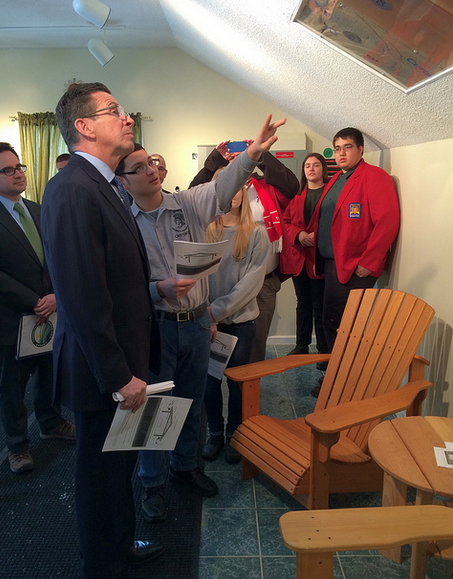Plan Will Increase Economy by $532 Million and Save Ratepayers Between $68 to $186 Million
#HARTFORD, CT – Governor Dannel P. Malloy today announced that, as part of the package of proposals he will introduce later this month, he will sponsor legislation for a new residential solar incentive model designed to save ratepayers millions of dollars, create local jobs in the clean energy sector, and increase renewable energy in the state.
This legislation will create the Solar Home Renewable Energy Credit (SHREC) as a cost-effective solution to meet increasing homeowner demand for residential solar energy, continuing already significant growth in the sector. A SHREC policy is projected to save Connecticut ratepayers from $68 to $168 million on Class I RPS (Renewable Portfolio Standard) policy costs over the life of the program, while supporting the creation of over 6,000 jobs and contributing $532 million to the state economy.
“We are making Connecticut greener, cleaner and more efficient than ever before, and we’re doing it by increasing private investment. Our programs are showing that we can combat global warming, protect the environment, and create local jobs by encouraging green energy,” Governor Malloy said. “We have seen incredible success with our Residential Solar Investment Program, and this new plan furthers our commitment to achieve our broader energy, environmental, and economic development goals. It’s a major step forward.”
As residential solar is an essential element of the Governor’s clean energy agenda, the SHREC capitalizes upon the already successful measures of Connecticut’s Residential Solar Investment Program (RSIP) – a policy passed in July of 2011 as part of a major clean energy bill that has rapidly exceeded expectations.
Similar in design of the current Zero Emissions Renewable Energy Credit/Low Emissions Renewable Energy Credit (ZREC/LREC) programs, the SHREC will partner the state’s electric utilities with Connecticut homeowners so that the utilities can purchase a 15-year stream of renewable energy credits (RECs) produced from the homeowners’ solar systems. In turn, the SHREC would attract over a $1 billion of private investment in residential solar Photovoltaic (PV) systems in Connecticut, making solar PV more accessible and affordable to ratepayers throughout the state.
The Connecticut Green Bank, which administers the RSIP, provided the incentives leading to over 8,000 installations of residential PV systems across the state, effectively doubling the 2011 legislative target of 30MW by 2022 eight years ahead of schedule. In addition to increasing the volume of residential solar projects, the RSIP has also reduced installed costs by 30%, decreased incentives by 70%, attracted $175 million in low-interest and long-term financing from local banks and credit unions, and increased investment in the market from $10 million in 2011 to over $160 million in 2014 making it the fastest growing market for residential solar PV in the region.
“Connecticut’s Residential Solar Investment Program has been extremely successful in attracting private investment in clean energy deployment in our state making solar PV more accessible and affordable than ever before,” said Bryan Garcia, president and CEO of the Connecticut Green Bank. “The SHREC will allow us to continue deploying clean energy in our communities through local contractors who do the installations, local lenders who provide the capital, and customers who benefit from cleaner and cheaper energy.”
Although Connecticut, like most states, has a Renewable Portfolio Standard (RPS) directing utilities to secure renewable energy on behalf of ratepayers, only 5% of the electricity used to fulfill RPS is currently produced in-state. The SHREC will help to address this problem by funding an RSIP that can continue to encourage local projects increasing economic development and job creation within Connecticut’s borders.
Commissioner Robert Klee of Connecticut’s Department of Energy and Environmental Protection (DEEP) said, “One major focus of Governor Malloy’s Comprehensive Energy Strategy is to increase the use of renewable energy in our state. By offering another innovative financing technique to leverage the power of private capital, SHREC will bring down the cost of solar systems for homeowners and help us accomplish that important goal.”
The Governor’s initiatives will be included in his legislative package of proposals for the 2015 session of the General Assembly.
About the Connecticut Green Bank
The Clean Energy Finance and Investment Authority was established by Connecticut’s General Assembly on July 1, 2011 as a part of Public Act 11-80. This new quasi-public agency, now known as the Connecticut Green Bank, superseded the former Connecticut Clean Energy Fund. The Green Bank’s mission is to lead the green bank movement by accelerating private investment in clean energy deployment for Connecticut to achieve economic prosperity, create jobs, promote energy security and address climate change. As the nation’s first full-scale green bank, the organization leverages public and private funds to drive investment and scale-up clean energy deployment in Connecticut. For more information about Connecticut’s Green Bank, please visit www.ctcleanenergy.com
.

